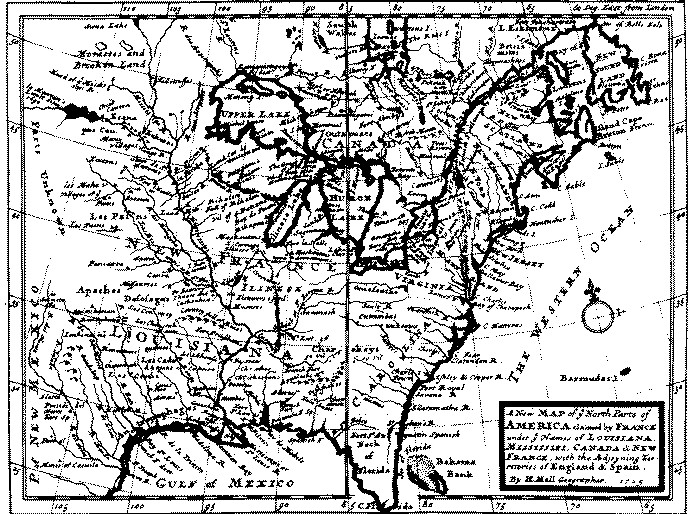 If you looked at a map of North America at that time, you would
notice the colours of Britain and France crossing over an area in the Ohio
Valley, New Brunswick and south of Hudson Bay.
If you looked at a map of North America at that time, you would
notice the colours of Britain and France crossing over an area in the Ohio
Valley, New Brunswick and south of Hudson Bay.
*** Index * Next chapter > ***
The Seven Years War (1756-1763) was one of the major conflicts in history since the fall of Rome. It had Bourbon King Louis XV on one side trying as hard as possible to repeat the golden days of Louis XIV and Frederick II of an emerging Prussia backed by British gold provided by William Pitt on the other.
The Seven Years War was mainly the result of trading rights. The British colonials (Americans) were pinned up against the Atlantic seaboard, with only the Hudson Bay company in the north challenging the French trading. With thirty-three times the population in less than half the land area, the British found the need to expand. But doing so, they would enter the Ohio Valley, controlled by France.
 If you looked at a map of North America at that time, you would
notice the colours of Britain and France crossing over an area in the Ohio
Valley, New Brunswick and south of Hudson Bay.
If you looked at a map of North America at that time, you would
notice the colours of Britain and France crossing over an area in the Ohio
Valley, New Brunswick and south of Hudson Bay.
Acadia (Nova Scotia and New Brunswick), established by the French by Champlain in 1604 (he turned Stadacona, a trading post, into Quebec in 1608) was the main cause of conflict before France in 1713, on its knees, had to cede it to Queen Anne of Britain.
The first war in a series of four was ![]() the King William's War. It
was fought by William III, Stadtholder of the Netherlands, King of England,
Scotland and Ireland to stop Louis XIV from completing his grand design.
the King William's War. It
was fought by William III, Stadtholder of the Netherlands, King of England,
Scotland and Ireland to stop Louis XIV from completing his grand design.
It had little influence on North American affairs although Frontenac terrorized New England after Sir William Phips took his ships up to the walls of Quebec and Frontenac replying "I will answer you with the mouths of my cannons and muskets." Phips withdrew.
The second, Queen Anne's War (War of Spanish Succession) a revival of the grand design, saw France losing to Marlbourgh in Europe at Bleinheim, Ramillies, Malplaquet, the capture of Gibraltar, but Louis XIV's grandson, Philip, Duc d'Anjou placed on the Spanish throne.
The main effect of the war in Canada, was the loss of Acadia to the French - a loss from which French Canada would never recover.
The third was ![]() the King George's War (War of Austrian Succession). It saw
Frederick II of Prussia take advantage of Maria Theresa come to the throne
of the Holy Roman Empire undertook to capture Silesia after the fifty year
old claims to Juliers and Berg were rejected.
the King George's War (War of Austrian Succession). It saw
Frederick II of Prussia take advantage of Maria Theresa come to the throne
of the Holy Roman Empire undertook to capture Silesia after the fifty year
old claims to Juliers and Berg were rejected.
The war grew with ![]() the War of Jenkins ear (an Englishman who had his
ear cut off by the guarda coasta) and finally France, Spain and Prussia
against Austria and England. French privateers, operating out of the
Fortress of Louisbourg destroyed New England commerce, so governor William
Shirley with 4000 colonials from New England with the help of the Royal
Navy, sailed to besiege it.
the War of Jenkins ear (an Englishman who had his
ear cut off by the guarda coasta) and finally France, Spain and Prussia
against Austria and England. French privateers, operating out of the
Fortress of Louisbourg destroyed New England commerce, so governor William
Shirley with 4000 colonials from New England with the help of the Royal
Navy, sailed to besiege it.
With blunders of enormous proportions on the French side, Louisbourg fell, only to be traded for land in India. This sowed the seeds of discontent in New England, which would continue to grow until 1775.
The final conflict was the Seven Year's War or French and Indian War. In Europe, it had England and Prussia, against France, Spain and Austria. With English settlers flowing through the Appalachians, France had to act quickly and started building a chain of forts along the Ohio Valley.
*** Index * Next chapter > ***